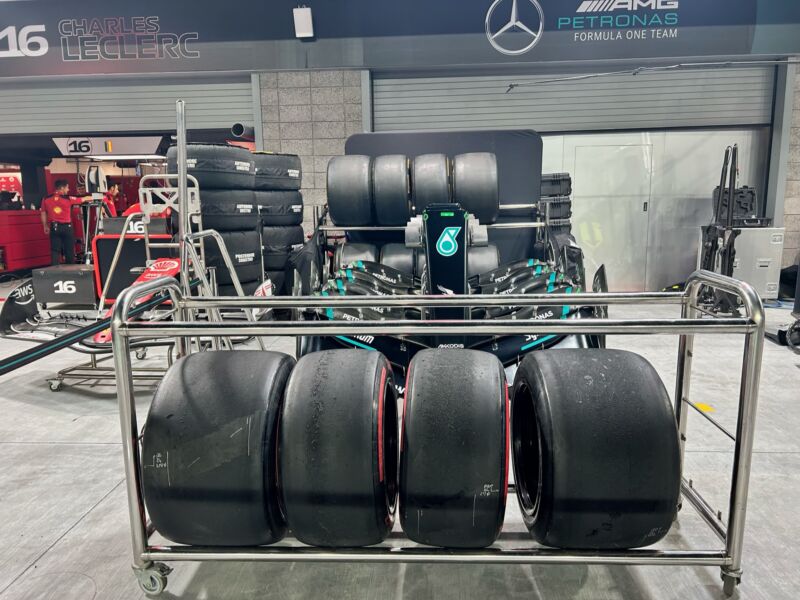
LAS VEGAS—It was cold this past weekend at the first Las Vegas Formula 1 Grand Prix. Winters in the desert are notoriously chilly, and it didn’t help that the race organizers decided to start the spectacle at 10 pm local time.
The issue was the tires—they’re not developed to handle frigid weather. Teams were tracking air temperatures and formulating plans to keep their cars on the road instead of sliding into a wall. There was some relief the night of the race, as the weather was warmer than it was during Friday night’s qualifying session. At the start of the race (according to Weather Underground) it was roughly 60° F (15.5° C), and the actual lowest air temperature was still 10° F warmer than the historical average for November 18; turns out climate change is real and happening.
There’s nothing subtle about Formula 1. Big egos, big money, big tracks, and thanks to a certain Netflix show, big-time fan growth in the United States. But at its core, the actual cars themselves, relatively speaking, don’t have that big of an impact on the environment. Sure, they’re loud V6 engines, and the tires get depleted quicker than a pizza at a children’s birthday party; but transporting the cars and pit equipment and tires and team members to each race uses far more energy than the race itself. And of course, if you factor in fans flying in from all over the world for the 23 races per year, you get a larger carbon footprint than, say, your kid’s soccer game.
But that footprint is eclipsed by a season of NFL or NCAA football matches (where annual attendance dwarfs F1, and most of those fans drive to the games), and baseball games seem to happen every five minutes during baseball season. (It’s actually 162 regular season games a year for 30 teams which means, 2,430 games a year. That’s 32,805 hours of baseball based on the average length of a game lasting 162 minutes. The regular season is 185 days long, which equals 4,440 hours. So there’s more baseball than time.)
Still, F1 and its tire supplier, Pirelli, realize they don’t exist in a vacuum, and ignoring things like climate change won’t make it go away—and frankly, every little bit helps. On the powertrain side, in 2026 the hybrid motors in the F1 cars will be more powerful. More energy from electricity versus gasoline is always a good move, and the actual petrol is also being changed up. The goal is synthetic carbon-neutral fuel by 2027. A commendable plan, but like with all things that require a huge change, it’s not without its issues.
Use fewer tires
Then there are the tires. Mario Isola, head of Pirelli F1, told Ars Technica, “During our 13 years, we’ve had many new races. I have to say that Las Vegas is one of the most difficult because the weather expected was colder. Our tires are not designed to work in very cold conditions,” Isola said.
Just ask Lando Norris about this—the low temperature was a factor in causing his McLaren to bottom out on a bump on the track, which sent him violently into a crash barrier and then to a hospital for precautionary checks.
Yet Pirelli is well aware of the climate crisis and is working to reduce its impact on the world. Currently the used race tires are returned to the UK and used as fuel. Pirelli is now working to reuse these tires by breaking them down into plastic that can be used for flooring. There are also schemes to recycle the tires to create new raw materials to be used in other new tires, so the rubber you see racing on track one weekend might end up on the wheels of another vehicle months later.
This is at the same time that Pirelli is having to develop new tires for the smaller, lighter, and more powerful cars due in 2026. The company has already started down the path of sustainability and announced that next year its tires will be FSC-certified (Forest Stewardship Council).
Isola also noted that Pirelli wants to reduce the number of tires that are used on race weekend. This year it’s piloting a system where it supplies 11 sets of slicks instead of 13. It’s a 20 percent reduction in tires, and it means transporting fewer tires around the world. Pirelli hopes to make this the standard for the future.
Pirelli is also working to remove the heating blankets from wet and intermediate tires. Doing that reduces electricity usage and would mean fewer items to ship around the world. All of these plans individually seem like small potatoes, but like the transition to a more sustainable future, it’s the little things that add up to a larger impact on how we affect the world.
https://arstechnica.com/?p=1986065

